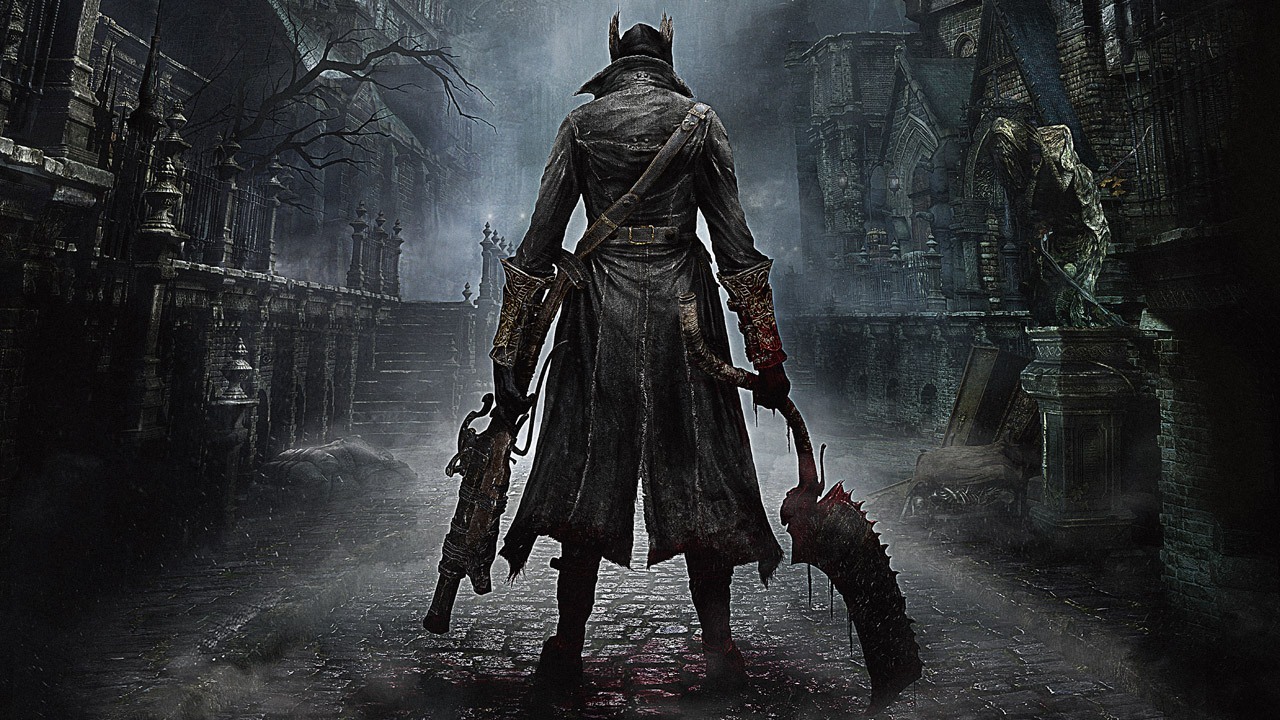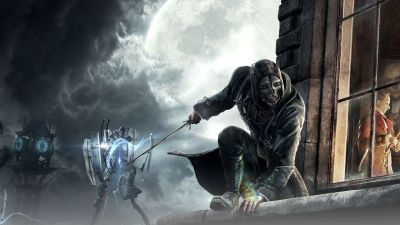Famed horror author H.P. Lovecraft once said, “Pleasure to me is wonder - the unexplored, the unexpected, the thing that is hidden and the changeless thing that lurks behind superficial mutability” and no one sentence better defines the experience of playing Bloodborne for the first time.
We’ve had a good run of “scary” games over the past two years, but true horror is a rarity in modern media. Scares are cheap and easy to manufacture, often leaving us almost as fast as they appeared. It is true horror that lingers, keeping us up at night as it lingers around our minds as it makes us question our everyday surroundings. Horror is at the heart of Bloodborne, and it is relentless in pursuit of that as you’ll encounter waking nightmares while you uncover the unseen in From Software’s homage to the classic American Author.
Dark times have befallen the Victorian city of Yharnam, once a bastion for a great religion that wielded the power to cure any ailment. Now the city has shut itself off from the outside world, and it’s gates closed to prevent anyone or thing from leaving. You awaken in the city as an outsider, you shouldn’t be here. Yharnam isolated itself for a reason - the great healing no longer works; plague and death spreads through the streets as the populace hunts what should not be.
From Software seems to have embodied themselves in the first enemy encountered you’ll find in the game, a hulking werewolf guarding the door between you and the rest of the Yharnam. I can almost guarantee that more than a few of you died to that wolf in what would become a familiar lesson between death and learning that the game is trying to teach.
“Welcome to Yharnam,” says the wolf. “Welcome to Bloodborne, we hope you have fun.”
Indeed the opening hours of Bloodborne felt reminiscent to my first encounters with Dark Souls, which was my first experience with Miyazaki’s personal blend of brutal difficulty and compelling reward loops. I felt completely helpless as I struggled to unlearn all the gameplay knowledge I had learned through three Souls games. I needed to adapt to the more aggressive nature of Bloodborne, and there are enough subtle changes here to throw off any but the best Souls players. This was a welcome change from the easier Dark Souls 2 - where I already knew what to expect from the game’s mechanics, leading me to rush through without so much as a pause.
Bloodborne sheds all the bloat and flaws that had grown over the three Souls games, culminating in Dark Souls 2. Gone is the abundance of covenants, magics, shields, rings, items, and weapons. Discarded are stats like weight, poise, and emcumbrerence. No longer are there arbitrarily difficult bosses that plagued the last entry in the Souls series.
What remains is the core gameplay that made the Souls games a joy to play for those willing to get past all those unexplained obstacles: rewarding combat and exploration.
To those already intimate with Miyazaki’s previous work, you’ll find everything to be both familiar yet different. For new hunters, you’ll find what is essentially the most accessible of all the Souls games. Sure, it appears to be difficult at its onset, but the game is trying to teach you how to play it before it opens up. Every death should be a learning experience, as From Software teaches you how to play. Bloodborne doesn’t start to open itself up to you until you’ve proven yourself against the first two bosses, who act as a sort of tutorial gate - preventing access to the more open world that exists behind them.
It is here that Bloodborne really starts to shine, as the entire city of Yharnam and its many secrets are now open for you to explore. Victorian cobbled streets give way to crowded alleyways; vaulted bridges connect various cathedrals and buildings to each other. Stone gargoyles top the buildings, and statues of people - seemingly frozen in time - litter their walls. From Software and director Hidetaka Miyazaki has created an atmosphere for Yharnam that teeters between nightmare and reality - the city is truly a central character in your journey through the game. Yharnam changes and grows and as your character gains insight into the true nature of the world, you’ll learn that there is more to what’s going on than meets the eye. Often I found myself pausing to stare in wonder at the architecture and level design. The sheer amount of detail packed into each environment is awe-inspiring.
The inhabitants of Yharnam match the city’s themes, ranging from angry mobs to horrifying walking nightmares - all on the hunt for you. You’re the hunted as well as the Hunter, and taking the city’s inhabitants for granted will soon find you staring at a reload screen. Combat engagements are fast, brutal, and above all else satisfying. New dodge and health regeneration mechanics serve as the central deviations from the combat in the Souls games. When locked onto an enemy you are able to swiftly dodge in any direction for little stamina cost, meaning that the move acts as both a retreat and engagement tool. The health regeneration serves compliments this maneuvre: when struck your health bar will reduce, but it will leave behind a faded portion of lost health that regenerates if you manage to strike an enemy within a short time window.
The most satisfying moments of Bloodborne’s combat come from the game’s Trick Weapons. Trick Weapons can change form on the fly between a one-handed short range form for fast attacks, or a longer-range slower attack (that can, but not always be two handed). The dual nature of each weapon you’ll collect effectively means that each new weapon you find brings with it two new playstyles to learn. The need to frequently switch between these forms mid-fight as new enemies entered the fray was something I welcomed. Did I mention the sound they make when you switch between forms? It’s the equivalent of Arnold Schwarzenegger cocking a shotgun before a big action scene in a film: you feel like a hunter badass every time you hear the distinct pop of metal snapping into place.
The ability to dodge and heal through incoming damage means that you’ll no longer need those cumbersome shields you amassed from your time in the Souls games (though in what appears to be a self-referential joke, one does appear early on). Instead, in your offhand you wield a firearm.
As rudimentary as they may be, ranged weapons serve as a way to stun enemies mid-attack and set up powerful counter attacks (here called Visceral attacks), or to control crowds with scattershot and flames. Your offhand trinkets are powered by Silver Bullets, limiting the amount of times you can use them. This forces you to make a few in-game decisions about resource management: do you use this attack on your current opponent, or save it for whatever unseen enemy lurks around the corner? And don’t forget your trusted Hunter’s Torch, that can burn and stun enemies to halt their advance - plus it always helps in the darkest bowels of the city.
The new weapon types and fast-paced combat culminates in what could be some of From Software’s most accompolished boss encounters to date. I white-knuckled my way through several bosses with hands aching from tensely gripping the controller. There are fewer of these bosses than in previous games, and I’m sure that I’ve yet to encounter a handful of hidden bosses that are off the beaten path. The ones that I did find were all memorable experiences; unlike Dark Souls 2, none of them feel like copies, or generic mobs leveled up to boss status. Some of them follow a similar theme, but each has its own personality and feels unique. Some are massive monstrosities, while others are human-sized adversaries. Even more form a series of linked events emphasizing a story beat, marking a turning point in the narrative. Most of these encounters are comprised of multiple phases and attack patterns, but even more have hidden tricks found only through experimentation and diligence.
Exploration and progress will reward you with chalices and other items, which you can then use to open up new randomly-generated Chalice Dungeons to share with other players online or tackle alone. While these dungeons are comprised of pre-defined rooms that are randomly linked together to create whole levels, each Chalice Dungeon feels hand-crafter, with little repetition. At the end of each dungeon lurks a unique boss encounter not found in the main game, and each contains plenty of loot, lore, and further extend a game that already has high replay value. Chalice Dungeons are perfect for co-op and it is now much easy to group up with friends, something not possible in the Souls games.
Unfortunately there are a few cracks in the Neo-Gothic cathedral of excellence. Bloodborne has quickly gained notoriety for its loading times, which can reach up to twenty seconds (with some reporting up to 40 seconds, but I’ve not experienced anything that bad). The loading screens on their own aren’t a huge problem for me. But but I can see issues arising for newer players who are dying regularly, forcing them to stare at the a loading screen over and over.
There are also some rather infrequent parts where the frame rate will drop well below 30 and even 20 frames per second. Camera issues also rear their head, sometimes making it difficult to see what you’re doing as you get assaulted from an enemy off-screen. These are all problems that were present in previous From Software games, dating all the way back to the Armored Core series, but it’s disappointing that more time wasn’t spent to alleviate the issues prior to release. Thankfully, the developer has already promised that a patch is on the way which should improve performance, and issues with the framerate and camera are infrequent and minor enough to be overlooked by most players. To long time fans of the series, they are a part of From Software’s charm.
Bloodborne is a great experience, but it may not be a great experience for everyone. I’ll avoid recycling the tired “casual” and “hardcore” generalizations here, but Miyazaki’s games have always demanded a level of skill that not every player may be ready for. It’s up to you to make a decision about whether Bloodborne is a game for you, and it’s ok to admit if the game is too difficult - just be forewarned that you will find yourself facing a stiff challenge right from the start of the game.
Bloodborne is a humbling experience, one that can often relentlessly frustrating - but it is also fair. From Software wants you to beat their game, and none of your deaths feel as though the game has cheated you. Every death feels as if it was your fault, leading you to ask yourself what you can do to avoid further frustration. Bloodborne is a faster-paced and often more chaotic game than its Souls brethren, but playing it has taught me more patience than that series ever did. I learned to dodge and read attacks - which was something I struggled with before - and you absolutely need to, or you won’t get far into the game before becoming frustrated and putting it away. Excel or die, as they say.
If you’ve been waiting for a reason to justify your purchase of a PlayStation 4 but have been let down so far with the system’s exclusives, then Bloodborne is the game which could well redeem Sony’s latest console in your eyes; From Software has made its distinctive brand of gaming more accessible to new players without sacrificing the integrity of their design philosophy.
If this is your first time with a From Software game, enjoy it - because you’ll never get this feeling back again.







Pingback: Bloodborne Expansion Confirmed | Continue Play()